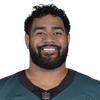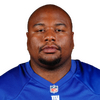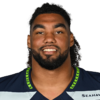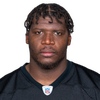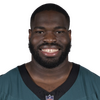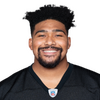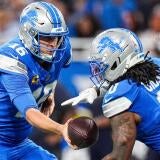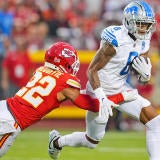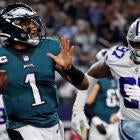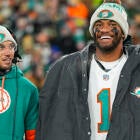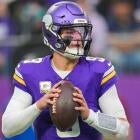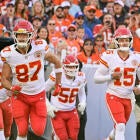Agent's Take: 2025 ultimate 53-man roster that's the best team money can buy
A look at our ultimate 53-man roster, with salary cap and draft restrictions taken into account
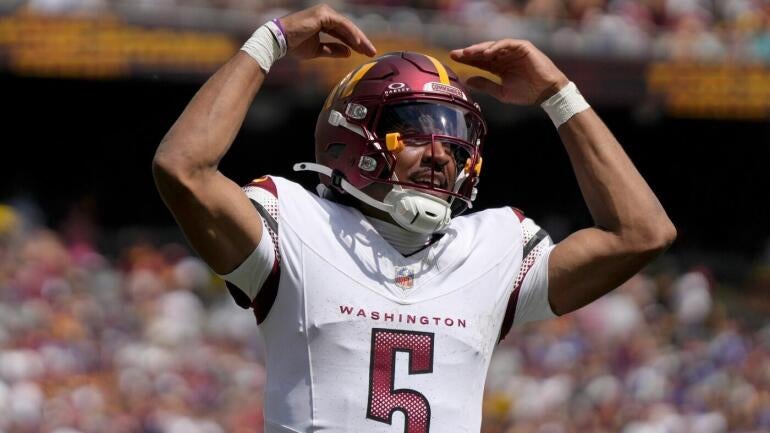
Creating the ultimate 53-man roster is easy when there aren't any parameters. It's more challenging when operating under a salary cap. Roster construction becomes more complicated with other restrictions designed to help prevent a squad from resembling last season's All-Pro team. The constraints bring more realism to the selection process. The ground rules are as follows.
Parameters
The salary cap for the roster is $293.3 million, although the actual NFL salary cap is $279.2 million for this year. The number being used approximates the average adjusted salary cap, according to NFLPA data. Each NFL team's working salary cap varies largely because unused cap room can be carried over from one year to the next. For example, the San Francisco 49ers have the NFL's highest adjusted salary cap at $341.46 million, largely thanks to carrying over just under $50.1 million of cap room, the most in the league. The Buffalo Bills have the lowest at $273.17 million, $6.03 million below the league-wide number. Situations like this typically occur when incentives earned during the previous season that weren't counting on the cap get accounted for without sufficient cap room carrying over from the prior year to make up the difference.
The NFL Draft is an essential element of roster building for NFL teams. It is here as well. One player from each round of the 2025 draft must be on the roster. The number requirement drops by one player for each year of the preceding three drafts (2022-2024). The limit of one player per round remains. Thus, only four 2022 draft picks are required. There's one other draft pick constraint: only one 2021 first-round pick whose fifth-year option was exercised is allowed. This means a choice must be made between Cincinnati Bengals wide receiver Ja'Marr Chase, Green Bay Packers edge rusher Micah Parsons, Detroit Lions right tackle Penei Sewell and Denver Broncos cornerback Patrick Surtain II. Selecting a 2021 first-round pick isn't a necessity.
The backups at each position are limited to players who aren't established starters, were reserves in 2024 or lost a starting job this year. Young veterans cracking the lineup for the first time are eligible as reserves. Those starting last season only because of an injury are also fair game as backups. Players competing for starting jobs in the preseason or where there's a "by committee" approach at a position, usually running back, are also acceptable. A backfield containing Saquon Barkley and Derrick Henry, 2024's leaders in rushing yards, is prohibited since both are workhorse running backs.
Choosing a player who was given a franchise or transition designation in 2025 is optional. However, only one player receiving a 2025 designation can be selected.
Roster-building philosophy
A salary cap-friendly potential franchise quarterback is the most valuable commodity in the NFL because of the roster flexibility provided by the low cap number. Choosing one was a necessity.
The old football adage of "it starts in the trenches" was also an overriding principle in assembling the roster. An emphasis was placed on the offensive and defensive lines. There are three starting cornerbacks instead of a traditional base defense (either 3-4 or 4-3), since five or more defensive backs are now used over 60% of the time in the NFL.
Players with cap numbers above $20 million were kept to a minimum; only two such players were selected. Having one of the five biggest cap numbers at a position was largely avoided.
Long-range planning wasn't taken into account, so worrying about future salary cap obligations, the amount of cap room that could be carried over, expiring contracts and drafting players who might develop into starters down the road wasn't necessary. Different choices would have been made if these aspects had been considerations.
Here's the team I assembled, with some of my thoughts behind the selections. Within each player card is his 2025 cap number and draft slot (if necessary).
Offense
Jayden Daniels is a tremendous value among starting quarterbacks since he is in the second year of his rookie contract. It would have been foolish to pass up the roster flexibility Daniels' cap number provides compared with Josh Allen and Lamar Jackson, the last two NFL MVPs, who count $36,338,431 and $43.5 million against the cap, respectively.
Daniels arguably had the best rookie season ever for a quarterback. He established himself as one of the top dual-threat quarterbacks while guiding the Commanders to their first NFC Championship game appearance since the 1991 season after going 4-13 in 2023 prior to his arrival. The 2024 NFL Offensive Rookie of the Year completed 69.0% of his passes for 3,568 yards with 25 touchdowns and nine interceptions to post a 100.1 passer rating. He added a rookie-record 891 yards on the ground and scored six times.
Saquon Barkley had a season for the ages in 2024. He became the ninth player in league history to rush for 2,000 yards in a season. His league-leading 2,005 yards were eighth on the all-time list. Barkley would have had a legitimate chance at breaking Eric Dickerson's 40-year-old single-season record of 2,105 rushing yards if the Eagles hadn't rested him in the regular-season finale against the New York Giants. His 5.8 yards per carry were fourth in the NFL. Barkley added 278 yards on 33 receptions to lead the NFL with 2,283 yards from scrimmage (combined rushing and receiving yards). His 15 total touchdowns (13 rushing and two receiving) were tied for seventh in the league.
Barkley is a threat to score any time he touches the football. He is the only player in NFL history with more than four touchdown runs of at least 60 yards in a season (regular season and playoffs). Barkley had three such runs in the playoffs, a postseason record, in addition to four in the regular season, for a total of seven.
The best NFL wide receiver discussion only involves two players: Justin Jefferson and his former LSU teammate, Ja'Marr Chase. Jefferson bounced back from an injury-plagued 2023 season in which he missed seven games with a right hamstring injury. He had 103 catches for 1,533 yards and 10 touchdowns. It was the third time Jefferson cracked the 1,500 receiving-yard mark in his five NFL seasons. Chase's omission is due to his $23.57 million cap number and stiff competition for the 2021 first-round pick that were better values.
Nico Collins got off to a hot start in 2024, leading the league with 567 receiving yards when he hurt his right hamstring five games into the season. He still had his second straight 1,000-yard season despite missing five games. Wide receivers of Collins' caliber on veteran contracts typically do not have cap numbers under $10 million.
There isn't a better wide receiver value than Puka Nacua, since he won't be eligible to sign a contract extension until the 2025 regular season ends on Jan. 4. Nacua set single-season records in 2023 with 105 receptions and 1,486 receiving yards. Las Vegas Raiders tight end Brock Bowers established a new receptions mark last season.
Trey McBride had a career year with 111 receptions and 1,146 receiving yards. He ranked fourth in the NFL in receptions and second among tight ends in both categories.
A healthy Tristan Wirfs ($11,506,142) would have been the choice over Jordan Mailata at left tackle. Wirfs is still sidelined from right-knee surgery in early July. Mailata, an excellent run blocker, surrendered only 14 quarterback pressures in 12 games last season, per Pro Football Focus. Trent Williams' $21,141,955 cap number eliminated him from consideration.
Joe Thuney has been a model of consistency at left guard for several years. He tied for ESPN's best pass-block win rate among offensive guards last season. Quenton Nelson (Indianapolis Colts), with a $22,770,619 cap hit, made the decision easier.
Creed Humphrey is clearly the league's best center following Frank Ragnow's retirement. He provides the NFL's best combination of run and pass blocking at the position.
Quinn Meinerz rewarded Denver's faith in giving him a four-year, $72 million contract extension (worth up to $80 million through salary escalators) at the start of training camp in 2024 with his first All-Pro season. The other option was Chris Lindstrom (Falcons) whose $12,258,505 cap number more than doubles Meinerz's.
The 35-year-old Lane Johnson shows no signs of slowing down. He didn't give up a sack and allowed just 10 quarterback pressures in 2024, per PFF. The limitation with 2021 first-round picks kept Penei Sewell ($9,548,505) off the squad.
Defense
Myles Garrett tied for the league lead with 83 quarterback pressures and was second in sacks with 14. He also had PFF's best pass-rush win rate at 23.1% in 2024. Garrett is slightly more affordable than 2024 sack leader Trey Hendrickson (Cincinnati Bengals), who has a $25,166,668 cap number. Maxx Crosby (Las Vegas Raiders) was not considered due to having 2025's largest cap number for a non-quarterback at $38,163,330.
Dexter Lawrence is a force against both the run and pass. He recorded a career-high nine sacks last season despite missing the final five games due to a dislocated left elbow.
Leonard Williams had the best season of his career in 2024, leading interior defensive linemen with 11 sacks. Selecting Lawrence eliminated Chris Jones (Kansas City Chiefs), whose $23.6 million cap number would have made two defensive tackles over $20 million unfeasible.
Aidan Hutchinson probably would have gotten the nod over Anderson and the 2022 first-round pick slot instead of cornerback Sauce Gardner if Patriots cornerback Christian Gonzalez was healthy. The 2023 first-round pick missed the regular season opener with the hamstring injury he suffered early in training camp. Anderson's best football is ahead of him. The 2023 NFL Defensive Rookie of the Year tied for 10th in the league with a career high 11 sacks last season.
Fred Warner is generally considered as the game's top off-ball linebacker. He plays the run as well as he does the pass. Warner and Roquan Smith (Baltimore Ravens) have earned first team All-Pro honors in each of the last three seasons. Smith's $23,720,955 cap number was too cost prohibitive for consideration.
Zack Baun was one of the NFL's biggest surprises last season in transitioning from edge rusher to inside linebacker in 2024. In addition to finishing tied for sixth in the NFL with 151 tackles, he also recorded five forced fumbles, the second-most in the league, becoming the only player in NFL history with at least 150 tackles and five forced fumbles in a season. Baun made the Pro Bowl, earned first-team All-Pro honors for the first time and was a finalist for NFL Defensive Player of the Year.
Patrick Surtain II is the NFL's top cornerback. The 2024 Defensive Player of the Year intercepted four passes with a league-leading 132 return yards. He usually covers the opponent's best wide receiver.
Sauce Gardner had a down year by his standards after consecutive first-team All-Pro seasons, but that didn't stop the Jets from making the 2022 NFL Defensive Rookie of the Year the league's highest-paid cornerback at $30.1 million per year. Trent McDuffie (Chiefs), who was 2022's 21st-overall pick, was very attractive because of a $4,460,029 cap number, but Gardner has more size at 6-foot-3. A lower 2025 cap number than fellow 2022 first-round pick Derek Stingley Jr.($12,034,637) tipped the scales in favor of Gardner.
Marlon Humphrey will primarily play in the slot. He had a career-high six interceptions in 2024, tied for the most among cornerbacks, and earned first-team All-Pro honors.
Kerby Joseph led the NFL with nine interceptions and earned first-team All-Pro honors.
Brian Branch joins Joseph at safety. The duo is arguably the NFL's best safety tandem. Kyle Hamilton's 2025 cap number increasing to $8,733,620 in the four-year, $100.4 million extension he recently signed with the Ravens -- to reset the safety market at $25.1 million per year -- factored into the equation.
Specialists
Brandon Aubrey made 76 of 85 field-goal attempts (89.4%), including 24 of 27 from 50 yards or more in his first two NFL seasons (2023–2024). No kicker made more from 50-plus yards during that span.
Logan Cooke's 44.8-yard net punting average was second in the NFL last season. He placed 34 of 68 punts inside the 20-yard line and had only three touchbacks.
Andrew DePaola has earned Pro Bowl honors in each of the past three years.
Derius Davis led the NFL with 16 yards per punt return (2023) and averages 24.9 yards per kickoff return over his career. He handles both return duties.
Reserves
Quarterback
Jake Browning played just five offensive snaps last season. In 2023, he started seven games when Joe Burrow was sidelined, going 4-3 and keeping the team in playoff contention. He led the NFL with a 70.4% completion rate in 2023.
Running backs
Mason did a nice job filling in for Christian McCaffrey while he missed the first eight games last season with tendonitis in both Achilles. In those eight games, Mason had 685 rushing yards on 134 attempts to average 5.1 yards per carry. Mason joined Aaron Jones, who had a career high 1,138 rushing yards last season, in Minnesota's backfield after the 49ers dealt the restricted free agent in March.
Allgeier rushed for 644 yards on 137 attempts complementing Bijan Robinson. He had over 1,000 rushing yards as a rookie in 2022 prior to Robinson's arrival.
The Commanders felt comfortable enough with Croskey-Merritt's progress to trade Brian Robinson Jr. to the 49ers during the latter part of the preseason.
Matlock is a unique fullback because he's plays on both sides of the ball. He took 137 snaps as a defensive lineman in 2024.
Wide receivers
Vele was a pleasant surprise as a 2024 seventh-round pick. He had 41 receptions, 475 receiving yards and three touchdown catches with the Broncos as a rookie. Improved wide receiver depth made Vele expendable in Denver. He was traded to the Saints for a 2026 fourth-round pick and a 2027 seventh-round pick in the preseason.
Ayomanor appears to be a favorite target of 2025 first-overall pick Cameron Ward.
Davis' primary contribution is returning kicks.
Note: Reserve cornerback Travis Hunter will also see wide receiver snaps.
Tight ends
Fant was a salary cap casualty by the Seattle Seahawks in July as the start of training camp was approaching.
Steelers offensive coordinator Arthur Smith referred to Washington as a dominant blocking tight end last season. NFL Media's Daniel Jeremiah, who was a scout for three different NFL teams, and former NFL general manager Doug Whaley believe the jumbo sized tight end could make the transition to offensive tackle.
Offensive line
"Experience is the best teacher" is the philosophy for the offensive line depth.
Christensen's versatility made him attractive. He can play every offensive line position.
Paul is the only one on a rookie contract. He will be the swing tackle.
Risner had started 80 of the 87 games he had played heading into this season mostly at left guard. He can play either guard spot.
James was the Raiders' starting center for all but two of the 61 games he played over the 2021 through 2024 seasons before his release in March.
Edge rushers
Judon, who has 72 career sacks, makes the transition to a situational pass rusher. He had four sacks in the Falcons' final seven games last season.
Elliss was a 2024 All-Rookie team selection with five sacks while being on the field for 37.58% of Denver's defensive snaps.
Defensive tackles
Milton Williams' departure from Philadelphia in free agency is opening up more playing time for Ojomo. His 18.2% pass rush win rate was second among interior defensive lineman who had at least 300 pass rushing snaps last season, according to PFF.
Stuffing the run will be Black's primary function.
Linebackers
King, Muasau, Sanborn and Strnad's main contributions will be on special teams.
Sanborn was usually productive with the Bears, but his opportunities were limited because of Tremaine Edmunds and T.J. Edwards. He was probably relieved that the Bears didn't tender him as a restricted free agent in March.
Strnad got his first extensive action of his NFL career in 2024 because of injury. The Broncos signing Dre Greenlaw during the offseason has made Strnad a Broncos reserve again.
Cornerbacks
Some believe Hunter has a higher ceiling as a cornerback than a wide receiver.
Johnson is a first-round talent who slipped to the second round after an injury-plagued 2024 season.
Jones is on his third NFL team in four seasons because of inconsistency and off-the-field problems. He's just cornerback depth at league minimum salary.
Safeties
Diggs, a 12 year veteran, can play either safety position. A starter since the 2017 season, Diggs is backing up Xavier Woods in Tennessee.
Watts has quickly made a positive impression on Falcons All-Pro safety Jessie Bates III.
Hicks' playing time increased dramatically as the 2024 season progressed. The Chiefs were comfortable enough with Hicks to let Justin Reid walk in free agency.
Final thoughts/tale of the tape
- Total salary cap used (53 players): $289,908,495
- Remaining salary cap room: $8,005,733
- Offense (25 players): $128,137,133
- Defense (25 players): $151,995,244
- Specialists (3 players): $5,276,118
Positional breakdown
(Salary cap percentage in parentheses)
- QB: $9,625,794 (3.28%)
- RB: $12,004,567 (4.09%)
- WR: $28,041,261 (9.56%)
- TY: $13,749,253 (4.69%)
- OL: $64,716,258 (22.06%)
- EDGE: $35,517,509 (12.11%)
- DT: $40,706,782 (13.88%)
- LB: $25,219,178 (8.6%)
- CB: $41,039,613 (13.99%)
- S: $9,512,162 (3.24%)
Not all cap room is used. A cushion is left for a full 16-player practice squad (approximately $4.7 million ) and to sign players when the inevitable injuries happen during the season. There is a larger allocation of cap resources to defense, which is expected given the modest quarterback cap expenses. 43.69% of the cap is devoted to offense while 51.82% is devoted to defense. Offensive line accounts for 22.06% of cap space, just over half of the offensive expenditure (50.5%). Defensive line takes 25.99% of the cap.
The Super Bowl LIX champion Eagles lead the way with five players selected. The Broncos and Vikings, 2024 playoff teams, follow with four players. Six teams (Bills, Packers, Colts, Raiders, Patriots and Buccaneers) have no players on this roster. The Buccaneers, Bills and Packers all made the playoffs in 2024.













